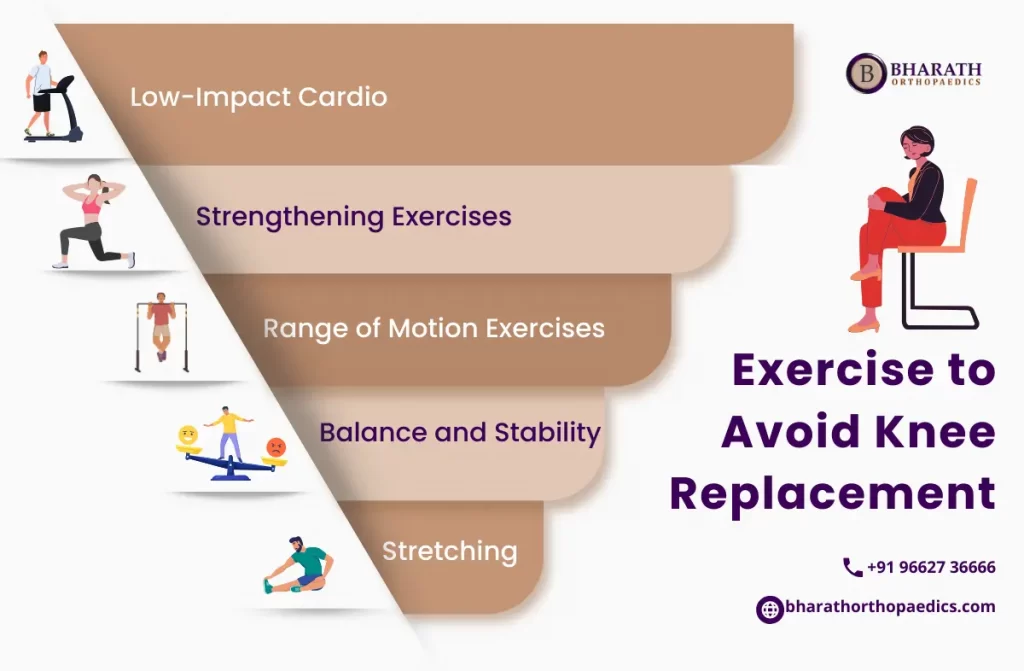Knee pain can be debilitating and frustrating, making it important to choose the right exercises to support your knee health. While staying active is crucial for overall well-being, some exercises can exacerbate knee pain and potentially lead to further injury. In this article, we’ll explore ten exercises to avoid in knee pain and suggest alternative options to keep you active and pain-free.
10 Exercises to Avoid in Knee Pain
Deep Squats
Deep squats require a significant range of motion at the knee joint, which can put excessive pressure on the knees, especially if you have existing pain or conditions like osteoarthritis. Exercises to avoid in knee pain include deep squats. Instead, opt for shallower squats or partial squats, focusing on proper form and control.

Lunges
Lunges involve bending both knees at once, which can strain the knees if not executed correctly. To reduce knee strain, it’s essential to be cautious of exercises to avoid in knee pain like lunges. Swap out traditional lunges for reverse lunges or step-ups, which put less stress on the knee joint and still work the lower body effectively.
High-Impact Cardio
High-impact activities like running or jumping can be hard on the knees. When dealing with knee pain, it’s advisable to steer clear of exercises that involve high-impact movements. Consider low-impact alternatives like cycling, swimming, or using an elliptical machine to get your cardiovascular workout without straining your knees.
Leg Press Machine
The leg press machine can place excessive pressure on the knees, particularly if you use heavy weights. It’s essential to be mindful of exercises to avoid in knee pain, including the leg press machine. Instead, focus on leg exercises that engage multiple muscle groups, such as leg curls or seated leg raises.
Leg Extensions
Leg extension machines can place a lot of stress on the knees, potentially exacerbating pain or causing injury. Replace leg extensions with exercises to avoid in knee pain like leg curls to target your quadriceps without risking knee strain.
Burpees
Burpees involve rapid transitions between standing, squatting, and jumping, which can be jarring on the knees. Try modified versions of exercises to avoid in knee pain or substitute them with alternatives like planks, mountain climbers, or wall sits.
Running Downhill
Running downhill can put significant stress on the knees due to the constant impact. If you enjoy trail running, consider running on flatter terrain or invest in proper footwear with adequate cushioning and support, as this can help alleviate stress on the knees in exercises to avoid in knee pain.
Jumping Jacks
Jumping jacks can strain the knees, especially if done with improper form or at a high intensity in exercises to avoid in knee pain. Opt for lower-impact alternatives like seated leg lifts or seated marches to work on cardiovascular fitness without risking knee discomfort.
Leg Raises with Weights
Holding weights on your ankles during leg raises can put unnecessary strain on your knees. Instead, perform exercises to avoid in knee pain like leg raises without weights, or try seated knee extensions with lighter resistance.
Full Range Leg Circles
Full-range leg circles can place undue stress on the knee joint. Modify exercises to avoid in knee pain by reducing the range of motion or opt for gentler leg exercises like seated leg circles or leg swings to minimize knee strain.
Exercise to Avoid Knee Replacement
it’s essential to consult with a healthcare professional or physical therapist for personalized advice based on your specific condition and needs. Here are some tips for exercise to avoid knee replacement:
- Low-Impact Cardio: Engage in low-impact cardiovascular exercises like swimming, stationary biking, or using an elliptical machine. These activities can help improve your cardiovascular fitness without putting excessive stress on your knees.
- Strengthening Exercises: Strengthen the muscles around your knee, especially the quadriceps (front thigh muscles) and hamstrings (back thigh muscles). Examples of exercises include leg lifts, leg curls, and squats.
- Balance and Stability: Work on balance and stability exercises to help improve joint stability. Standing on one leg, using a balance board, or practicing yoga and tai chi can be beneficial.
- Range of Motion Exercises: Perform a gentle range of motion exercises to maintain and improve knee flexibility. Ankle pumps, ankle circles, and gentle knee bends can help prevent stiffness.
- Stretching: Incorporate regular stretching into your routine to maintain or improve flexibility in your leg muscles. Stretch your quadriceps, hamstrings, calves, and IT band.
Remember that it’s crucial to listen to your body and not push yourself too hard, especially if you have a knee condition. If you experience severe pain or discomfort during any exercise, stop immediately and consult a healthcare professional. They can provide you with a comprehensive plan to manage your knee health and potentially avoid the need for knee replacement surgery.
Conclusion
When you have knee pain, it’s crucial to prioritize exercises that support your knee health and reduce the risk of further discomfort or injury. Always consult with a healthcare professional or physical therapist before starting a new exercise routine, especially when dealing with knee pain. Incorporating exercises to avoid in knee pain is equally important. Additionally, consider including strength training and flexibility exercises to improve knee stability and mobility. With the right approach, you can stay active and work towards a pain-free future.
Read also Exercises after Spine Surgery.

